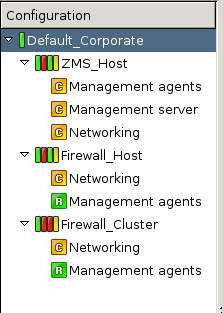The configuration tree lists the configurable components of a Zorp system. Whenever an item is selected in the configuration tree, the main workplace displays the configurable parameters of the selected item. The configuration tree is organized hierarchically and this hierarchy maps the management philosophy of Zorp.
The topmost item in the configuration tree is the 's name that has been entered during ZMS host installation. There are usually one or more items below it: ZMS and/or Zorp hosts.
In the most basic scenario, where ZMS is installed on the Zorp machine, there is only one machine listed. Note that in this case the name that appears here is the name of the ZMS host entered during installation. Under each host, a varying number of configuration components are listed.
By default two components are available for each host:
Management agentsNetworking
Because the ZMS Host in this example is a Management server too, it has a third component for configuring management server parameters.
Each site, host, and component has status icons or leds on its left. These are described in detail in Section 3.3.6, Status indicator icons.
The number of components increases with the configuration: many services have standalone configuration components that that have to be added to the configuration tree to be able to use them. The number of components increases as you start the real work: many services have standalone configuration components that you have to add to the configuration tree to use them.
The forthcoming chapters deal with these components in detail.
Published on May 30, 2024
© BalaSys IT Ltd.
Send your comments to support@balasys.hu



